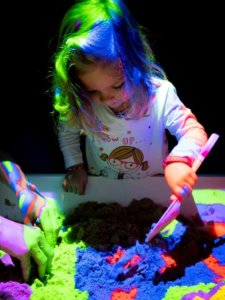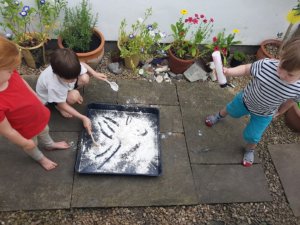10 Dry Messy Play Ideas Those Who Are Hypersensitive
Messy play is a great activity for children of all abilities. Among other benefits, picking up, manipulating and engaging with objects of different size, shape and texture is a great way to develop hand function.
However, not all children enjoy messy play. If our child is Autistic or has Sensory Processing Disorder they may be hypersensitive to touch, which can make exploring different textures an unpleasant or scary thing to do. They may even gag when they touch something that their system interprets as being unpleasant.
Unfortunately, these sensory difficulties can hinder our child’s development. Avoiding touch can limit our child’s play and self-care skills – for example, they may be rigid about the kids of toys they play with and may need to be fed by an adult to avoid touching food. Not using their hands can also result in delayed fine motor abilities.
Trying to desensitise our child to messy play is a slow and steady process. Little and often is the best way forward: introduce activities regularly only but for short bursts of time. Our child really needs to feel secure, so it is important to read their responses and not force them to play if they are uncomfortable or upset. We also need to consider how we ourselves react to the materials: our child will look at our response first to determine whether they feel safe enough to try the activity themselves.
When introducing messy play, we should start with dry materials that do not leave a sticky/dirty residue on the hands. Some of our children are also sensitive to smell, so it’s useful to use items with no odour. Having water, a towel and/or wipes to hand shows our child they can clean their hands as soon as they want or need to.
If our child does not initially want to touch the substance we select, we can use utensils, funnels and zip lock bags filled with the material as a way to play.
Below we share a list of our favourite dry messy play items, as well as a little more on the benefits of messy play.

Messy play allows for hand strengthening and developing hand-eye coordination. It provides a lot of sensory input and is a fun place for learning and developing gross and fine motor skills.
There is a strong cause and effect with messy play so children with limited fine motor skills can still make a big impact. This is great for learning and enjoyment.
Many children with different abilities have trouble with their sense of touch: either feeling too much (hypersensitivity, which can lead to tactile defensiveness) or not feeling enough (hyposensitivity, which leads to sensory seeking behaviours). Messy play is a controlled way to encourage tactile sensitive children to get used to different sensations. This can allow them to tolerate more of their everyday textures. The part of the brain which feels what is happening in the fingers and what happens in the mouth are close to each other in the brain, so if a child gets used to a texture with their hands it is going to make it easier to tolerate this in their mouth.
Feeling different textures is also good for stimulating brain development. Physical movements like two handed play and crossing the hands to the other side of the body during play, also helps brain development and body awareness.
Dry Messy Play Ideas to Try
Preparation is everything! Choose a place in the home or garden for messy play activities – ideally somewhere easy to clear up. You’ll need a surface to play on: tuff spot trays are brilliant for minimising mess, but you can also use trays or containers you already have in the home, or an easy to wipe playmat or table. You’ll also need water, wipes and a towel available nearby for washing hands. Decide what material you are going to play with in advance: some activities take a little while to put together, and you also might want to consider how to make them extra motivating for your child.
Choose a time to play where you are able to join in. Messy play should be an active experience that the child initiates in some way through imitation. If a child is nervous or unsure they might want to watch someone interact with the materials first, so you need to be prepared to get stuck in! Playing together with your child also means you can watch for ways to enhance or extend their play.
Before play, it’s really nice to massage, squeeze or brush your child’s fingers, hands and forearms. This alerts their system and brings awareness to the whole upper limb. A quick finger, hand or wrist stretch can also help them feel and manipulate the messy play substance more effectively.
Ideas for play: if your child is able, or with some hand over hand help, use kitchen utensils to play with the substance – using a wooden spoon to stir, a ladle or spoons to scoop or a potato masher to squish. You can use other things from around the home as tools to further develop motor skills, like paintbrushes, rolling pins, biscuit cutters, cutlery, containers, cups or sponges.
You can also put different objects into the substance for the child to play with. This is motivating and helps build fine motor and visual perception skills. Good options include cars, plastic animals or figurines, or you can tailor it to a special interest. Try dropping some items inside the substance for your child to find. Start with bigger objects so they hardly have to touch the messy play mixture; as they get more confident, hide or make the items smaller so your child has to get their hands in.
We have ordered these items with those most likely to be tolerated at the top. Work through the list slowly to give the child time to get more comfortable with each texture.
-
Dried pasta.
If a child doesn’t want to touch pasta, use buckets and spades or kitchen implements to scoop between different pots. -
Dried rice or lentils.
We can dye items different colours to make them more appealing. See our page on dyeing sensory materials. -
Little lego pieces.
-
Dried cereal.
Such as Cheerios, Rice Crispies or they could even break up Weetabix and get them to make it into powder. Mix different cereals together for different textures. -
Dried sand.
-
Dried Food.

Flour/sugar/salt/a bowl of breadcrumbs/oats – all for slightly different textures. Brown sugar stacks well and makes great sandcastles. -
Cotton balls or pom poms.
-
Playdough in a plastic bag.
This can be great for those who don’t want their hands too dirty. See our ‘Our Home‘ videos for details of great play dough activities. -
Slightly cooked pasta.
You could use glitter or mix with other textures like sand to make the texture different. -
Slightly wet sand/wet sand.
This is a good way to push your child a little further with something more wet. If your child isn’t comfortable, stick to dry play!






